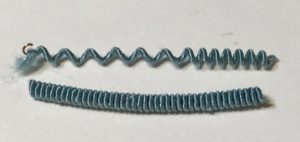Author: Katherine Diuguid
The wealth of needlework techniques on display in 17th century English raised-work embroideries is a reminder that these pictures functioned as samplers, in which amateur embroiderers would test out different techniques as they progressed in their needlework skills.
Whether depicting Biblical or mythological characters, female figures rendered in contemporary dress often enjoyed pride of place and were worked in very intricate detail. Here, the figures may represent the five senses. Each of the female figures has been worked in long and short stitch with flat silk. Flat silk is a fine silk thread that has not been twisted or “spun” and is sometimes called filament silk. This lack of texture and shadow gives this silk thread its extremely shiny finish. Their dresses are shaded in a vertical banded fashion, which does not follow the curvature of the dress. The stripes of the petticoat and the dress of the central character have been created by couching down bands of flat silk. Each character is outlined in color-coordinated twists or tiny cording.
The leaves of the pear tree reveal my favorite 17th-century raised work detail: each detached buttonhole leaf has a shadow, which has been worked in satin stitch with flat silk behind the needle-lace leaf! The hills that the characters are standing on are also worked using silk threads in different stitches to add texture and interest to the composition.
Another way silk has been used is in the form of silk-wrapped metal purl, seen in the leaves of the trees around the castle, the leaves in the strawberries, as well as the flowers beside the leopard and above the snail. Silk-wrapped purl is a metal drawn wire coil that has been wrapped with silk. These three-dimensional purls were worked in beautiful ways to add texture and relief. In this piece, purls of various colors have been cut into small pieces and stitched down to form densely packed loops. It’s interesting to me that in all the other techniques the shading has been executed in a banded manner, but with the silk-wrapped purl the colors have been mixed together in a random fashion, or used to highlight the tips of the leaves and petals. On this similar piece in Cooper Hewitt’s collection, the silk-wrapped purl can be seen worked in loops in shaded bands on the hill in the lower right corner.

Silk-wrapped purl. Top piece shows the piece stretched out to illustrate the thread construction of the silk wrapping around the metal coil.
Katherine Diuguid is a studio artist specializing in embroidery with a special focus on metal thread embroidery. She teaches embroidery workshops nationally and internationally.
